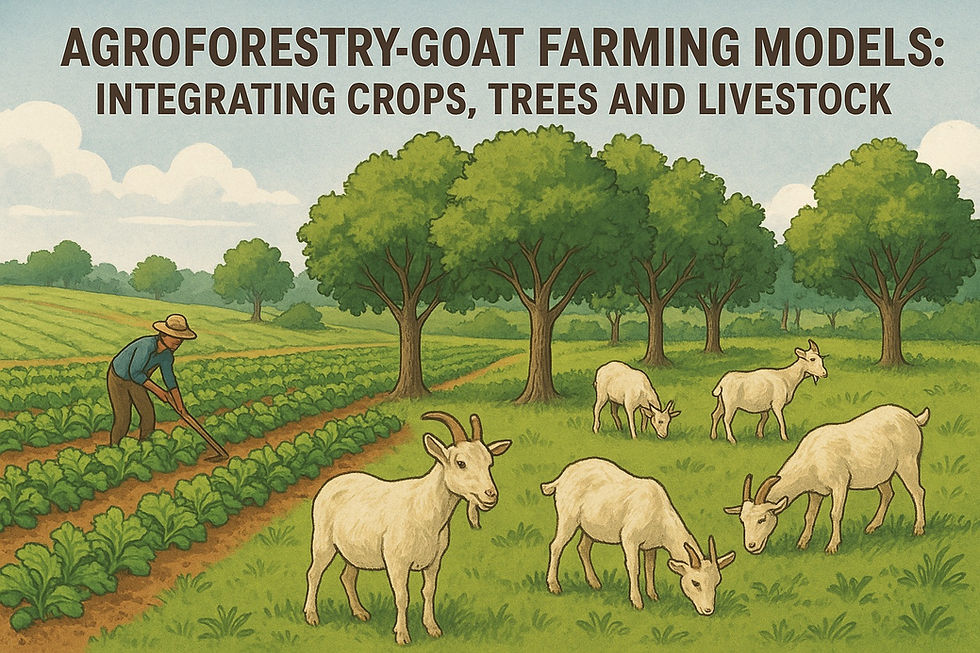Feeding the Future: Adapting Small Livestock Feed Practices to a Warmer India
- Global Services TGT
- Jul 22
- 3 min read
Updated: Jul 25
As India grapples with the intensifying impacts of global warming, small livestock farmers—particularly those raising goats, sheep and backyard poultry—face mounting challenges in securing adequate, affordable and climate-resilient feed for their animals. Feed scarcity, poor forage quality and rising input costs are increasingly threatening the viability of small-scale livestock farming. In India, the need to adapt livestock feed practices is not just an agricultural concern—it is a livelihood and food security imperative.
The Climate-Feed Connection: Rising temperatures and erratic rainfall patterns have direct and indirect effects on the availability and nutritional value of natural fodder and crop residues. Climate-induced droughts and delayed monsoons reduces pasture productivity and limit the growth of common fodder crops like sorghum, napier grass and berseem. Meanwhile, crop failures mean less availability of byproducts like wheat bran and oilseed cakes, which are vital components of livestock diets.
The quality of feed also deteriorates under heat stress conditions. Studies show that heat-stressed forage has reduced protein and higher fiber content, lowering its digestibility and nutritional value. For small ruminants, which are more sensitive to nutrient imbalances than cattle, this can lead to a decrease in productivity, poor health, and lower reproductive efficiency.
Strategies for Climate-Resilient Feeding: To meet the twin challenges of feed scarcity and climate stress, farmers and policymakers are exploring adaptive feed strategies tailored to India’s diverse agro-climatic zones.
· Drought-Tolerant Fodder Crops: Promotion of climate-resilient fodder varieties such as co-3 napier, guar (cluster bean), bajra (pearl millet), and stylo can help ensure year-round green fodder supply even under water-stressed conditions. These species require less water and offer higher yields under stressful climatic conditions.
·
Agroforestry and Fodder Trees: Integrating fodder trees like subabul (Leucaena leucocephala), sebania and gliricidia into small farms offers a sustainable source of high-protein green fodder, especially during dry seasons. Agroforestry systems also help in getting sequester carbon and improve soil health, creating a climate co-benefit.
· Hydroponic Fodder Units: Low-cost hydroponic fodder systems, using minimal water and space, are gaining popularity among smallholder farmers. These units can grow barley or maize sprouts within 7–10 days, providing a nutrient-rich supplement during fodder shortages.
· Feed Blocks and Pellets from Crop Waste: Technologies that convert agricultural waste like paddy straw, sugarcane bagasse and groundnut shells into nutri-rich feed blocks or pellets are being scaled in several Indian states. These innovations reduce dependence on traditional grazing and provide a compact, durable feed option. The potential of compressed feed in India is increasing and demand generating wherever it’s production initiated.
· Backyard Forage Gardens: Kitchen gardens and backyard plots can be repurposed to grow multi-cut grasses, leguminous creepers and herbs that are both drought-tolerant and livestock-friendly. This decentralizes feed production and empowers women and landless families to earn few bucks from its production.
Implications for Small Livestock Farmers: Adopting climate-resilient feeding practices is critical for enhancing milk yield, meat quality and animal health in small ruminants and backyard poultry. Improved feeding also reduces enteric methane emissions, aligning with climate mitigation goals.
However, the transition requires extension support, community training and micro-financing to enable adoption among marginal farmers. The involvement of Pashu Sakhis (community animal health workers), Farmer Producer Organizations (FPOs) and Krishi Vigyan Kendras (KVKs) is crucial in scaling these solutions.
Policy and Research Gaps: India's livestock feed policy still heavily favors large ruminants, leaving small livestock under-supported. Government programs must integrate small livestock-specific feed interventions into flagship schemes like Rashtriya Gokul Mission or National Livestock Mission. Additionally, climate-focused feed R&D needs more investment to tailor solutions for diverse geographies.
Feeding small livestock in a diverse climate India demands innovation, traditional knowledge and policy alignment. As climate challenges deepen, resilient feed practices are key to safeguarding livelihoods, nutrition and sustainability for millions of smallholder farmers. The path to future-ready farming begins with what we feed our animals today.



Comments